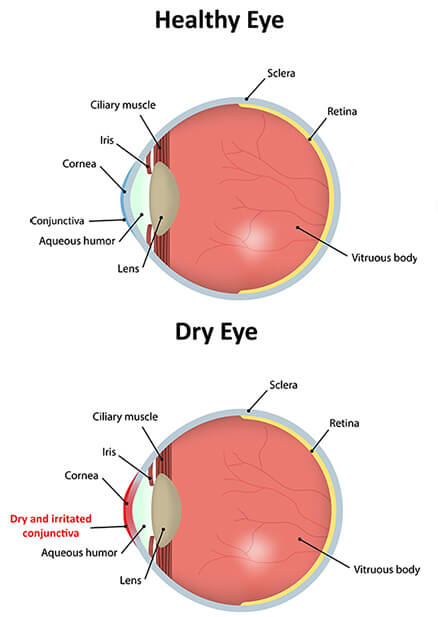
The American Academy of Ophthalmology estimates that over 4.8 million men and women in the United States over age 50 have dry eye disease. When over-the-counter eye drops are ineffective in helping control the constant irritations of this condition, it’s time to learn about more effective methods for relief. The most effective way to treat dry eye is to first learn why it is occurring.
Our physicians use advanced techniques to identify the specific cause of dry eye and recommend the most effective treatment.
You need a healthy tear film in order to coat, nourish and protect your cornea. The tear film is made up of three critical components: mucous, liquid, and oil. When there is a shortage of any of these components, your eyes will feel irritated, and vision may be affected. In fact, fluctuations in vision with blinking may be the only symptom of dry eye disease in certain patients. There are different reasons why the tear film may not function properly, and often, multiple mechanisms are at play.
Oil producing meibomian glands located within the eyelids become blocked and atrophy so that there is not enough oil on the surface of the tear-film. Meibomian Gland Dysfunction (MGD) is another term for Evaporative Dry Eye, and it is estimated 86% of all dry eye cases have some component of MGD.
Microscopic cells on the ocular surface do not produce enough liquid tears / mucous.
A critical function of the eyelids is to “paint” an even layer of tears over the surface of the eye with each blink. Some patients routinely make incomplete blinks, particularly when concentrating, and a portion of the cornea becomes dry. Our LipiView technology will show you how your blink.
Abnormalities in eyelid position that occur with aging, such as ectropion, where the eyelid no longer rides snuggly along the eye surface, can prevent the tear film from reaching the entire eye surface. Additionally, some patients do not fully close their eyelids at night, when they sleep.
Paradoxically, intermittent watering eyes can sometimes be triggered by underlying dry eye. Microscopic cells on the surface are not producing “baseline” tears triggering the lacrimal glands to produce a flood of tears, much like crying.

The right treatment depends on your type and severity of dry eye disease and often requires a combined approach.
To learn more about dry eye in Oceanside, California, contact us today.
Book Online